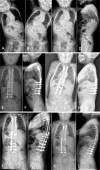Selecting the Substantially Touched Vertebra as the Lowest Instrumented Vertebra in Spinal Surgeries for B3GALT6 -Related Disorders: Clinical Experience and Literature Review
- PMID: 40371684
- PMCID: PMC12214426
- DOI: 10.1111/os.70072
Selecting the Substantially Touched Vertebra as the Lowest Instrumented Vertebra in Spinal Surgeries for B3GALT6 -Related Disorders: Clinical Experience and Literature Review
Abstract
Objectives: B3GALT6 -related disorders are characterized by severe early-onset spinal deformities requiring surgical corrections but are associated with increased risks of perioperative complications. This study reports the clinical experience and outcomes of selecting the substantially touched vertebra (STV) as the lowest instrumented vertebra (LIV) in spinal surgeries for patients with B3GALT6 -related disorders, a group of extremely rare skeletal and connective tissue disorders.
Methods: This retrospective study included patients who were molecularly diagnosed with B3GALT6 -related disorders and received spinal surgeries for (kypho)scoliosis between 2017 and June 2023. Their medical records were reviewed. We also conducted a systematic literature review to identify (kypho)scoliosis management in patients with B3GALT6 -related disorders.
Results: We identified a total of four patients. Patient 1 presented with severe kyphoscoliosis and segmentation defects and received a pedicle subtraction osteotomy with short fusion and dual growing rods from T3 to L3. However, coronal imbalance was observed at the 18-month follow-up. Genetic testing revealed biallelic disease-causing variants in B3GALT6 . A revision surgery was successfully performed, with the level of the LIV extended to the STV (L4). The LIV was similarly extended to the STV in the index surgery for subsequent Patients 2 and 3 who received preoperative genetic testing results, and no complication has been observed. Patient 4 underwent preoperative Halo-pelvic traction to minimize complications, followed by posterior spinal fusion. The curves were successfully reduced without complications. A systematic literature review identified 86 articles reporting (kypho) scoliosis management in 12 of the 63 patients with B3GALT6 -related disorders. Limited surgical experience has been reported, with an increased rate of complications, including death.
Conclusions: Selecting the STV as the LIV is recommended in spinal surgeries for patients with B3GALT6 -related disorders, considering the characteristic joint hypermobility associated with the condition. Additionally, preoperative Halo-pelvic traction may also be safe and effective. Furthermore, preoperative molecular diagnosis is essential for enabling precision medicine and minimizing complications.
Keywords: Ehlers‐Danlos syndrome; genetic testing; joint instability; operative; scoliosis; surgical procedures.
© 2025 The Author(s). Orthopaedic Surgery published by Tianjin Hospital and John Wiley & Sons Australia, Ltd.
Conflict of interest statement
The authors declare no conflicts of interest.
Figures



Similar articles
-
Direct vertebral rotation (DVR) spinal instrumentation for the correction of adolescent idiopathic scoliosis Lenke 5 C.Eur Spine J. 2025 Jul;34(7):2739-2749. doi: 10.1007/s00586-025-09039-w. Epub 2025 Jun 10. Eur Spine J. 2025. PMID: 40493211 Clinical Trial.
-
Resolution of the lumbosacral fractional curve and evaluation of the risk for adding on in 101 patients with posterior correction of Lenke 3, 4, and 6 curves.J Neurosurg Spine. 2021 Jul 30;35(4):471-485. doi: 10.3171/2020.11.SPINE201313. Print 2021 Oct 1. J Neurosurg Spine. 2021. PMID: 35658389
-
Selection of Lower instrumented vertebra in early-onset scoliosis at index growth rod insertion- can we predict distal add-on at graduation surgery?J Craniovertebr Junction Spine. 2025 Apr-Jun;16(2):162-169. doi: 10.4103/jcvjs.jcvjs_86_24. Epub 2025 Jul 3. J Craniovertebr Junction Spine. 2025. PMID: 40756489 Free PMC article.
-
Patient and surgical predictors of 3D correction in posterior spinal fusion: a systematic review.Eur Spine J. 2023 Jun;32(6):1927-1946. doi: 10.1007/s00586-023-07708-2. Epub 2023 Apr 20. Eur Spine J. 2023. PMID: 37079078
-
Intraoperative image guidance compared with free-hand methods in adolescent idiopathic scoliosis posterior spinal surgery: a systematic review on screw-related complications and breach rates.Spine J. 2017 Sep;17(9):1215-1229. doi: 10.1016/j.spinee.2017.04.001. Epub 2017 Apr 17. Spine J. 2017. PMID: 28428081
References
-
- Bai X., Zhou D., Brown J. R., Crawford B. E., Hennet T., and Esko J. D., “Biosynthesis of the Linkage Region of Glycosaminoglycans: Cloning and Activity of Galactosyltransferase II, the Sixth Member of the Beta 1,3‐Galactosyltransferase Family (Beta 3GalT6),” Journal of Biological Chemistry 276, no. 51 (2001): 48189–48195, 10.1074/jbc.M107339200. - DOI - PubMed
Publication types
MeSH terms
Substances
Grants and funding
- 82172525/National Natural Science Foundation of China
- 2021-I2M-1-051/CAMS -Innovation Fund for Medical Sciences
- 2021-12M-1-052/CAMS -Innovation Fund for Medical Sciences
- 2022-I2M-2-001/CAMS -Innovation Fund for Medical Sciences
- 2023-I2M-C&T-A-003/CAMS -Innovation Fund for Medical Sciences
- 2022-PUMCH-C-033/National High Level Hospital Clinical Research Funding
- 2022-PUMCH-D-002/National High Level Hospital Clinical Research Funding
- 2022-PUMCH-D-004/National High Level Hospital Clinical Research Funding
- 2022YFC2703102/National Key Research and Development Program of China
- 2022YFC2703901/National Key Research and Development Program of China
- 2023YFC2507700/National Key Research and Development Program of China
LinkOut - more resources
Full Text Sources
Medical

